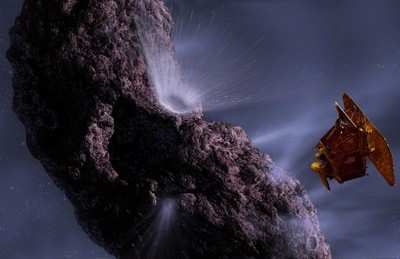Vehicle Being Disassembled For Part Replacement
The launch of the Deep Impact spacecraft has been rescheduled
for no earlier than Jan. 12. During a review of launch vehicle
hardware, it was discovered that some components of the inter-stage
adapter did not receive proper heat treatment and must be removed
and replaced. The inter-stage adapter is located between the first
and second stage of the rocket. A Boeing engineer reviewing an
"as-built" drawing of the vehicle discovered the inter-stage had
not been heat treated to a revised higher specification.
The second stage will be removed from the vehicle on Dec. 15,
the inter-stage adapter removed on Dec. 16, a new inter-stage
adapter installed on Dec. 17, and the second stage re-installed on
Dec. 18.

In processing activities at the Astrotech Space Operations
facility located near Kennedy Space Center, the high-gain antenna
used for Deep Impact communications with Earth has been installed.
The solar array panels have successfully completed an illumination
test as a final check of their performance. The flight battery
associated with the solar array panels has been installed. Fueling
of the spacecraft is scheduled to start on Dec. 19 and be completed
on Dec. 22. Mating to the payload attach fitting and upper stage
booster occurs Dec. 29 - 30.
At Launch Pad 17-B, the loading of liquid oxygen aboard the
first stage for a leak check and a countdown launch team
certification exercise occurred Dec. 13. The vehicle guidance and
control system check occurs on Dec. 28. The Flight Simulation, a
plus count that exercises all of the systems on the vehicle as they
will occur during powered flight, is scheduled for Dec. 29.
The Deep Impact spacecraft is now scheduled to be transported to
Pad 17-B on Jan. 3 and mated to the Boeing Delta II rocket. The
Flight Program Verification, the major integrated test with the
Delta II, occurs on Dec. 30. The Delta II payload fairing will be
installed around the Deep Impact spacecraft on Jan. 7.
The Deep Impact Mission
The mission is designed for a six-month, one-way, 431 million
kilometer (268 million mile) voyage. Deep Impact will deploy a
probe that essentially will be "run over" by the nucleus of comet
Tempel 1 at approximately 37,000 kilometers per hour (23,000 miles
per hour).
"From central Florida to the surface of a comet in six months is
almost instant gratification from a deep space mission viewpoint,"
said Rick Grammier, Deep Impact project manager at NASA's Jet
Propulsion Laboratory, Pasadena, CA. "It is going to be an exciting
mission, and we can all witness its culmination together as Deep
Impact provides the planet with its first man-made celestial
fireworks on our nation's birthday, July 4th."
The fireworks will be courtesy of a 1-by-1 meter (39-by-39
inches) copper-fortified probe. It is designed to obliterate itself
as it excavates a crater possibly large enough to swallow the Roman
Coliseum. Before, during and after the demise of this 372-kilogram
(820-pound) impactor, a nearby spacecraft will be watching the
6-kilometer-wide (3.7-mile) comet nucleus, collecting pictures and
data of the event.
"We will be capturing the whole thing on the most powerful
camera to fly in deep space," said University of Maryland astronomy
professor Dr. Michael A'Hearn, Deep Impact's principal
investigator. "We know so little about the structure of cometary
nuclei that we need exceptional equipment to ensure that we capture
the event, whatever the details of the impact turn out to be."
Imagery and other data from the Deep Impact cameras will be sent
back to Earth through the antennas of the Deep Space Network. But
they will not be the only eyes on the prize. NASA's Chandra, Hubble
and Spitzer space telescopes will be observing from near-Earth
space. Hundreds of miles below, professional and amateur
astronomers on Earth will also be able to observe the material
flying from the comet's newly formed crater.
Deep Impact will provide a glimpse beneath the surface of a
comet, where material and debris from the solar system's formation
remain relatively unchanged. Mission scientists are confident the
project will answer basic questions about the formation of the
solar system, by offering a better look at the nature and
composition of the celestial travelers we call comets.

"Understanding conditions that lead to the formation of planets
is a goal of NASA's mission of exploration," said Andy Dantzler,
acting director of the Solar System division at NASA Headquarters,
Washington, DC. "Deep Impact is a bold, innovative and exciting
mission which will attempt something never done before to try to
uncover clues about our own origins."
With a closing speed of about 37,000 kilometers per hour (23,000
miles per hour), what of the washing machine-sized impactor and its
mountain-sized quarry?
"In the world of science, this is the astronomical equivalent of
a 767 airliner running into a mosquito," said Don Yeomans, a Deep
Impact mission scientist at JPL. "It simply will not appreciably
modify the comet's orbital path. Comet Tempel 1 poses no threat to
Earth now or in the foreseeable future."
Ball Aerospace & Technologies in Boulder, CO, built NASA's
Deep Impact spacecraft. It was shipped to Florida Oct. 17 to begin
final preparations for launch. Principal Investigator A'Hearn leads
the mission from the University of Maryland, College Park. JPL
manages the Deep Impact project for the Science Mission Directorate
at NASA Headquarters.
 ANN's Daily Aero-Linx (04.13.24)
ANN's Daily Aero-Linx (04.13.24) ANN's Daily Aero-Term (04.13.24): Beyond Visual Line Of Sight (BVLOS)
ANN's Daily Aero-Term (04.13.24): Beyond Visual Line Of Sight (BVLOS) Airborne 04.09.24: SnF24!, Piper-DeltaHawk!, Fisher Update, Junkers
Airborne 04.09.24: SnF24!, Piper-DeltaHawk!, Fisher Update, Junkers Aero-News: Quote of the Day (04.14.24)
Aero-News: Quote of the Day (04.14.24) ANN's Daily Aero-Term (04.14.24): Maximum Authorized Altitude
ANN's Daily Aero-Term (04.14.24): Maximum Authorized Altitude




